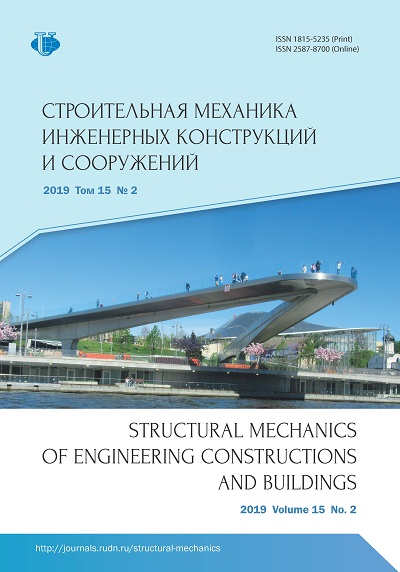Numerical analysis of layered composite panel behavior with interlaminar defects subject to dynamic loads
- Authors: Medvedskiy A.L1, Martirosov M.I2, Khomchenko A.V3
-
Affiliations:
- Moscow Institute of Physics and Technology (State University)
- Moscow Aviation Institute (National Research University)
- Irkut Corporation
- Issue: Vol 15, No 2 (2019)
- Pages: 127-134
- Section: Numerical methods of structures’ analysis
- URL: https://journals.rudn.ru/structural-mechanics/article/view/21080
- DOI: https://doi.org/10.22363/1815-5235-2019-15-2-127-134
Cite item
Full Text
Abstract
Aims of research. Polymer unidirectional composite laminate panel behavior with interlaminate defects under action of different dynamic loads is consider. Methods. Normal modes and eigenvalues of rectangular composite panels in the presence multiple delamination different sizes ellipsoidal form are calculated. The dependences of the maximum deflections from the frequency of the stationary pressure field action are constructed. Distribution field of panels plies failure index under action of nonstationary pressure field by using different failure criteria for composites is determined. Results. Modeling methodology composite panels behavior in the presence multiple interlaminar defects under action of different dynamic loads is developed. Analysis of failure panel with the use of different failure criteria for composites is carried out.
About the authors
Aleksandr L Medvedskiy
Moscow Institute of Physics and Technology (State University)
Author for correspondence.
Email: mdv66@mail.ru
DSc in Physical and Mathematical Sciences, Professor, Moscow Institute of Physics and Technology (State University).
9 Institutsky Pereulok, Dolgoprudny, 141701, Moscow region, Russian FederationMikhail I Martirosov
Moscow Aviation Institute (National Research University)
Email: vst@vst-st.ru
PhD in Technical Sciences, Docent, Moscow Aviation Institute (National Research University).
4 Volokolamskoe Shosse, Moscow, 125993, Russian FederationAnton V Khomchenko
Irkut Corporation
Email: khomchenkoanton@yandex.ru
Design Engineer 1 Category, Irkut Corporation.
68 Leningradsky Prospect, Moscow, 125315, Russian FederationReferences
- Medvedskiy A.L., Martirosov M.I., Khomchenko A.V. (2018). Chislennoe modelirovanie povedeniya plastiny iz polimernogo kompozita pod deistviem dinamicheskikh nagruzok pri nalichii mnozhestvennykh defektov mezhdu sloyami [Numerical modeling of polymer composite plate behavior under action of dynamic load at presence multiple defects between plies]. Tidings of TSU. Technical science, (10), 271-278. (In Russ.)
- Azzi V.D., Tsai S.W. (1965). Anisotropic strength of composites. Experimental Mechanics, 5(9), 283-288.
- Tsai S.W., Wu E.M. (1971). A general theory of strength for anisotropic materials. Journal of Composite Materials, (5), 58-80.
- Hoffman N.O. (1967). The brittle strength of orthotropic materials. Journal of Composite Materials, 1(2), 200-206.
- Puppo A.H., Evensen H.A. (1972). Strength of anisotropic materials under combined stresses. American Institute of Aeronautics and Astronautics Journal, 10(4), 468-474.
- Puck A., Schurmann H. (1998). Failure analysis of FRP laminates by means of physically based phenomenological models. Composites Science and Technology, (58), 1045- 1067.
- Puck A., Kopp J., Knops M. (2002). Failure analysis of FRP laminates by means of physically based phenomenological models. Composites Science and Technology, (62), 1633-1662.
- Puck A., Kopp J., Knops M. (2002). Guidelines for the determination of the parameters in Puck’s action plane strength criterion. Composites Science and Technology, (62), 371- 378.
- Hashin Z. (1980). Failure Criteria for Unidirectional Fiber Composites. Journal of Applied Mechanics, (47), 329-334.
- Norris C.B. (1962). Strength of orthotropic materials subjected to combined stress. U.S. Forest Products Laboratory. Report No. 1816.
- Fischer L. (1967). Journal of Engineering for Industry. Trans Am. Soc. Mech. Engrs., 89, 389-402.
- Norris C.B., McKinnon P.F. (1962). Compression, tension and shear tests on yellow-poplar plywood panels of sizes that do not buckle with tests made at various angels to the face grain. U.S. Forest Products Laboratory. Report No. 1328.
















